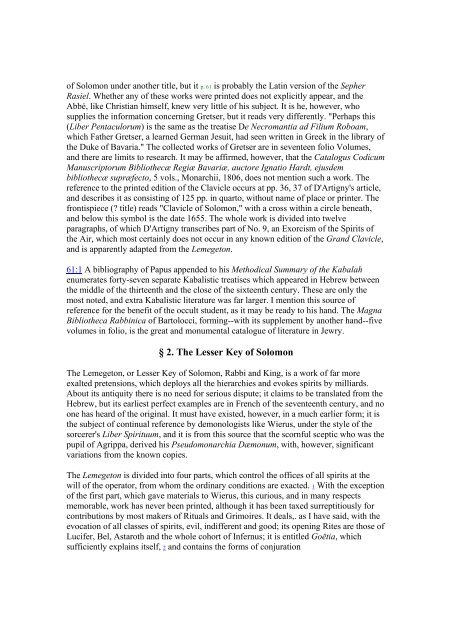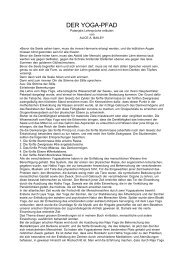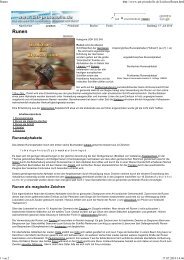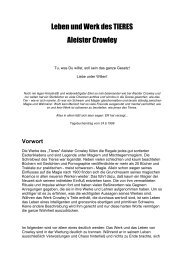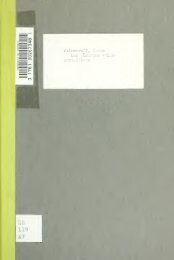The Book of ceremonial Magic
The Book of ceremonial Magic
The Book of ceremonial Magic
Create successful ePaper yourself
Turn your PDF publications into a flip-book with our unique Google optimized e-Paper software.
<strong>of</strong> Solomon under another title, but it p. 61 is probably the Latin version <strong>of</strong> the Sepher<br />
Rasiel. Whether any <strong>of</strong> these works were printed does not explicitly appear, and the<br />
Abbé, like Christian himself, knew very little <strong>of</strong> his subject. It is he, however, who<br />
supplies the information concerning Gretser, but it reads very differently. "Perhaps this<br />
(Liber Pentaculorum) is the same as the treatise De Necromantia ad Filium Roboam,<br />
which Father Gretser, a learned German Jesuit, had seen written in Greek in the library <strong>of</strong><br />
the Duke <strong>of</strong> Bavaria." <strong>The</strong> collected works <strong>of</strong> Gretser are in seventeen folio Volumes,<br />
and there are limits to research. It may be affirmed, however, that the Catalogus Codicum<br />
Manuscriptorum Bibliothecæ Regiæ Bavariæ, auctore Ignatio Hardt, ejusdem<br />
bibliothecæ supræfecto, 5 vols., Monarchii, 1806, does not mention such a work. <strong>The</strong><br />
reference to the printed edition <strong>of</strong> the Clavicle occurs at pp. 36, 37 <strong>of</strong> D'Artigny's article,<br />
and describes it as consisting <strong>of</strong> 125 pp. in quarto, without name <strong>of</strong> place or printer. <strong>The</strong><br />
frontispiece (? title) reads "Clavicle <strong>of</strong> Solomon," with a cross within a circle beneath,<br />
and below this symbol is the date 1655. <strong>The</strong> whole work is divided into twelve<br />
paragraphs, <strong>of</strong> which D'Artigny transcribes part <strong>of</strong> No. 9, an Exorcism <strong>of</strong> the Spirits <strong>of</strong><br />
the Air, which most certainly does not occur in any known edition <strong>of</strong> the Grand Clavicle,<br />
and is apparently adapted from the Lemegeton.<br />
61:1 A bibliography <strong>of</strong> Papus appended to his Methodical Summary <strong>of</strong> the Kabalah<br />
enumerates forty-seven separate Kabalistic treatises which appeared in Hebrew between<br />
the middle <strong>of</strong> the thirteenth and the close <strong>of</strong> the sixteenth century. <strong>The</strong>se are only the<br />
most noted, and extra Kabalistic literature was far larger. I mention this source <strong>of</strong><br />
reference for the benefit <strong>of</strong> the occult student, as it may be ready to his hand. <strong>The</strong> Magna<br />
Bibliotheca Rabbinica <strong>of</strong> Bartolocci, forming--with its supplement by another hand--five<br />
volumes in folio, is the great and monumental catalogue <strong>of</strong> literature in Jewry.<br />
§ 2. <strong>The</strong> Lesser Key <strong>of</strong> Solomon<br />
<strong>The</strong> Lemegeton, or Lesser Key <strong>of</strong> Solomon, Rabbi and King, is a work <strong>of</strong> far more<br />
exalted pretensions, which deploys all the hierarchies and evokes spirits by milliards.<br />
About its antiquity there is no need for serious dispute; it claims to be translated from the<br />
Hebrew, but its earliest perfect examples are in French <strong>of</strong> the seventeenth century, and no<br />
one has heard <strong>of</strong> the original. It must have existed, however, in a much earlier form; it is<br />
the subject <strong>of</strong> continual reference by demonologists like Wierus, under the style <strong>of</strong> the<br />
sorcerer's Liber Spirituum, and it is from this source that the scornful sceptic who was the<br />
pupil <strong>of</strong> Agrippa, derived his Pseudomonarchia Dæmonum, with, however, significant<br />
variations from the known copies.<br />
<strong>The</strong> Lemegeton is divided into four parts, which control the <strong>of</strong>fices <strong>of</strong> all spirits at the<br />
will <strong>of</strong> the operator, from whom the ordinary conditions are exacted. 1 With the exception<br />
<strong>of</strong> the first part, which gave materials to Wierus, this curious, and in many respects<br />
memorable, work has never been printed, although it has been taxed surreptitiously for<br />
contributions by most makers <strong>of</strong> Rituals and Grimoires. It deals,. as I have said, with the<br />
evocation <strong>of</strong> all classes <strong>of</strong> spirits, evil, indifferent and good; its opening Rites are those <strong>of</strong><br />
Lucifer, Bel, Astaroth and the whole cohort <strong>of</strong> Infernus; it is entitled Goëtia, which<br />
sufficiently explains itself, 2 and contains the forms <strong>of</strong> conjuration


